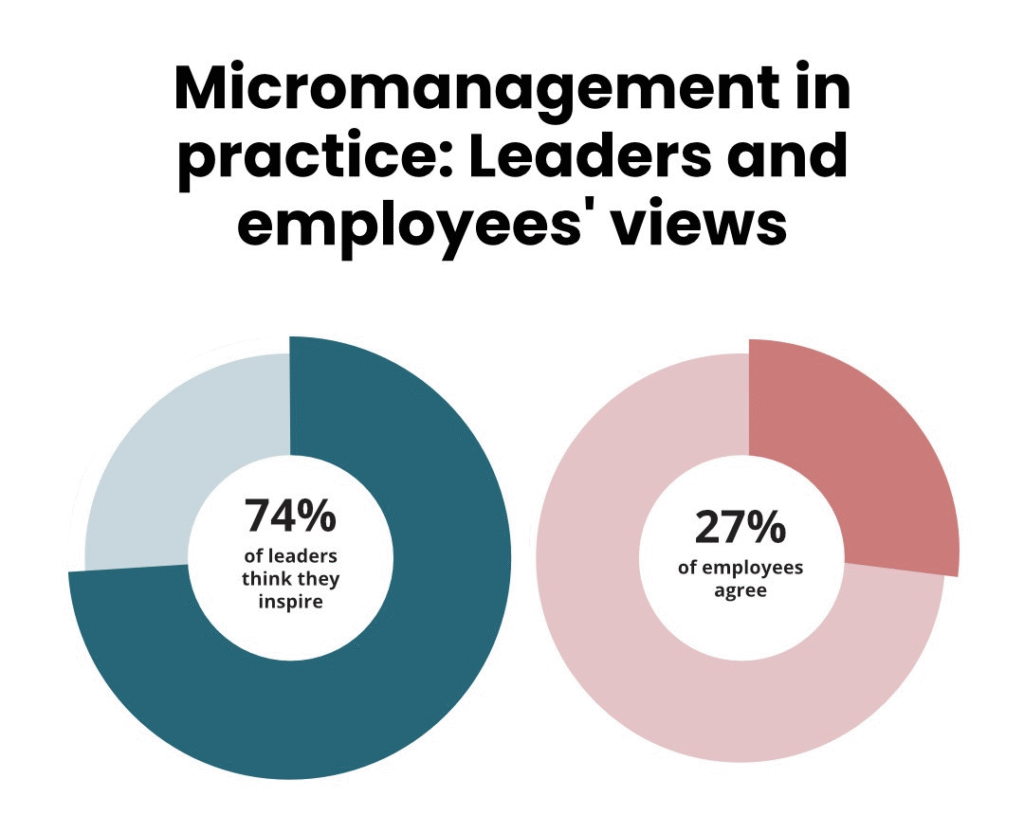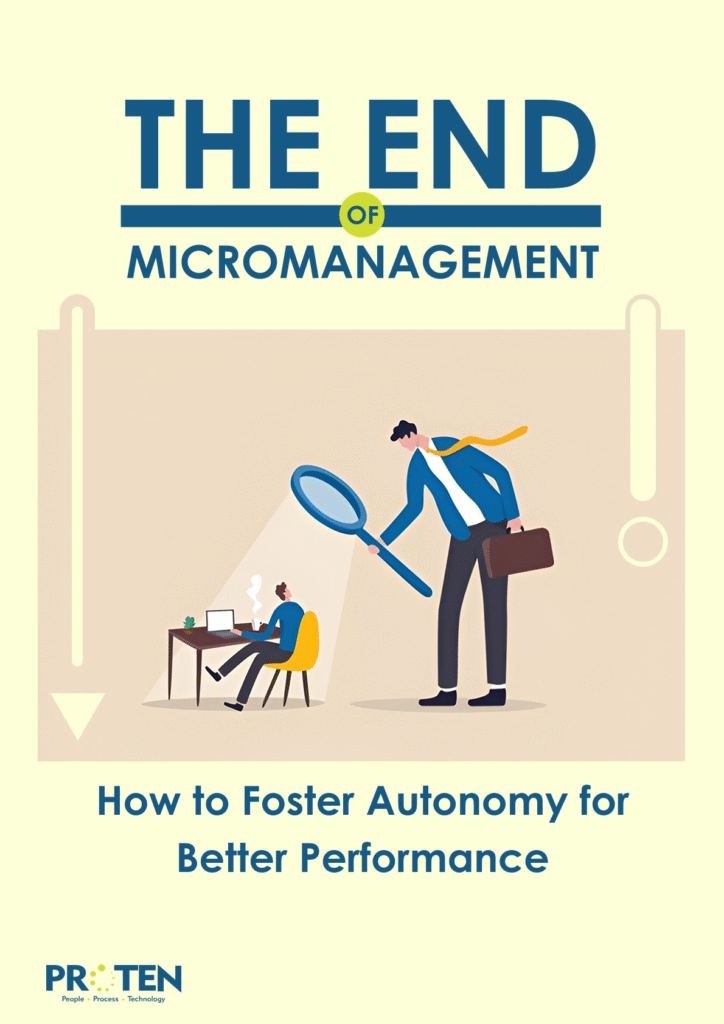Micromanagement has long been a pervasive issue in workplaces, often justified by managers as a means to maintain standards or mitigate risks. However, its negative impacts are well-documented. A 2023 study by Gallup found that 21% of employees report experiencing micromanagement, with those individuals showing 28% lower engagement levels compared to their peers. Similarly, a survey by the Society for Human Resource Management (SHRM) in 2024 revealed that 67% of employees who left their jobs cited micromanagement as a contributing factor.

Source: Life Hack
In today’s dynamic and competitive workplace, organisations are increasingly recognising the limitations of micromanagement—a leadership style characterised by excessive oversight, control, and involvement in employees’ day-to-day tasks. While micromanagement may stem from a desire to ensure quality and meet deadlines, research consistently shows it undermines employee morale, stifles creativity, and reduces productivity.
In contrast, fostering autonomy empowers employees to take ownership of their work, enhances engagement, and drives better performance outcomes. This insights report explores the decline of micromanagement, the benefits of autonomy, and actionable strategies for business leaders to cultivate a culture of trust and independence.
The Costs of Micromanagement

Source: Trinity Solutions
Micromanagement exacts a heavy toll on individuals, teams, and organisations. Its effects can be categorised into three key areas:
1. Employee Disengagement and Burnout
When managers excessively monitor tasks, employees feel distrusted and undervalued. A 2022 study published in the Journal of Organisational Behaviour found that micromanaged employees exhibit higher levels of stress and burnout, with a 35% increase in reported symptoms of anxiety compared to those given autonomy. This stems from a lack of psychological safety—the belief that one can take risks without fear of reprisal—which is eroded under constant scrutiny.
2. Stifled Innovation
Innovation thrives in environments where employees are free to experiment and problem-solve. Micromanagement, by contrast, imposes rigid processes that discourage creative thinking. Research from the Harvard Business Review (2023) indicates that teams with high autonomy generate 40% more innovative solutions than those under tight control, underscoring the link between freedom and ingenuity.
3. Reduced Productivity
Ironically, the very goal of micromanagement—improved performance—often backfires. A 2024 report by McKinsey found that micromanaged teams spend up to 20% more time on administrative tasks (e.g., reporting to managers) than on core responsibilities, leading to inefficiencies and missed opportunities.
The Benefits of Autonomy

Source: Effectory
Autonomy, defined as the ability to make decisions and control one’s work, is a cornerstone of modern leadership. Its advantages are supported by a growing body of evidence, with specific mechanisms that directly enhance performance across individual, team, and organizational levels.
1. Increased Engagement
Autonomous employees feel a stronger sense of ownership and purpose, which significantly boosts their engagement. According to Gallup’s 2023 State of the Global Workplace report, employees with high autonomy are 43% more likely to report job satisfaction and 31% less likely to seek new employment. This heightened engagement stems from psychological empowerment—when employees have control over their tasks, they experience greater self-efficacy, or the belief in their ability to succeed. Research from the Journal of Applied Psychology (2023) found that such empowered employees are 33% more likely to exceed performance expectations, as they proactively seek solutions rather than waiting for directives. For example, a 2024 case study of a tech firm in Fast Company showed that after implementing autonomy-focused policies, employees reported a 27% increase in confidence, further fueling their commitment to their roles.
2. Enhanced Performance
When employees are trusted to manage their workflows, they perform at higher levels, both individually and collectively. A 2022 meta-analysis in the Academy of Management Journal found that autonomy correlates with a 25% increase in individual productivity and a 15% improvement in team performance. This boost is partly due to reduced dependency on managers, freeing leadership to focus on strategic priorities rather than day-to-day oversight. Additionally, autonomy strengthens collaboration and team dynamics—contrary to the assumption that it leads to isolation, it fosters self-organising teams that leverage diverse skills to achieve outcomes more effectively.
3. Attraction and Retention of Talent
In a competitive labour market, autonomy is a differentiator that draws and retains top performers. A LinkedIn survey from 2024 revealed that 72% of professionals prioritise “freedom to work independently” when evaluating job offers, making it a critical factor in talent acquisition and retention. Organisations that empower their workforce signal trust and respect, aligning with the values of a modern workforce that prizes flexibility and purpose. This appeal not only attracts high-calibre candidates but also reduces turnover, as employees are more likely to stay in environments where they can shape their contributions and see tangible impacts.
Strategies for Fostering Autonomy

Source: AceUp
Transitioning from micromanagement to autonomy requires intentional effort from HR leaders and managers. Below are five evidence-based strategies, expanded with a robust framework for implementation.
1. Redefine Managerial Roles
This shift involves moving managers away from task-level oversight to a role focused on mentoring, aligning teams with organisational goals, and removing obstacles. Training should include workshops on active listening, asking open-ended questions (e.g., “What support do you need to succeed?”), and resisting the urge to intervene unnecessarily. For example, a retail chain might retrain store managers to focus on empowering staff to handle customer issues independently rather than dictating every step.
A 2023 SHRM study found that manager training programs focused on empowerment reduced micromanagement behaviours by 45% within six months. Organisations must train managers to act as facilitators rather than controllers, emphasising coaching over directing.
2. Set Clear Expectations
Clear, measurable outcomes give employees the “what” without prescribing the “how,” allowing them to innovate within defined boundaries. For instance, a marketing team might be tasked with boosting social media engagement by 15%, leaving them free to choose between video campaigns, influencer partnerships, or other tactics. This approach requires managers to articulate priorities, deadlines, and success metrics upfront, reducing ambiguity that often triggers micromanagement.
3. Leverage Technology
A 2024 Deloitte report found that organisations using collaborative tech saw a 22% reduction in micromanagement complaints. Technology can replace manual check-ins with transparent, real-time updates, allowing managers to monitor progress at a glance while employees retain control over their workflows. For example, a software development team might use Jira to track sprints, enabling the manager to see milestones without hovering over daily coding tasks. This also fosters accountability, as employees log their own progress.
4. Build a Culture of Trust
The Journal of Applied Psychology (2023) linked trust-based cultures to a 50% increase in employee loyalty. Trust is the bedrock of autonomy, requiring a cultural shift where experimentation is valued over perfectionism. Leaders can model this by sharing their own failures (e.g., a failed product launch that led to insights) and rewarding employees who try new approaches, regardless of outcomes. Recognition programs should spotlight individuals or teams who solve problems independently—e.g., a monthly “Autonomy Award” for innovative solutions. Open forums, like town halls, can also invite employee input on processes, reinforcing their voice.
5. Personalize Autonomy
Not all employees thrive with the same level of independence—new hires may need more guidance, while seasoned professionals can handle broader discretion. For example, a junior designer might start with specific deliverables (e.g., “create three logo options”) before progressing to open-ended projects (e.g., “revamp the brand identity”). Managers should assess readiness through performance reviews, skill assessments, and one-on-one discussions, adjusting autonomy incrementally. This ensures confidence and competence grow together.
Conclusion
A work environment created by micromanagement is inefficient and filled with unease. Employees who are made to feel that their work will never be good enough lose motivation and confidence in their ability to perform the tasks required for their position.
The end of micromanagement marks the beginning of a more empowered, innovative, and productive workplace. By fostering autonomy, organisations can unlock the full potential of their workforce, attract top talent, and stay competitive in a rapidly evolving landscape. This shift requires commitment—from redefining leadership to building trust—but the rewards are clear: engaged employees, breakthrough ideas, and sustained performance. As of today, the evidence is undeniable: autonomy is not just a trend, but the future of work.
Proten International has worked with various organisations to lay out and execute workplace transformational programmes to foster autonomy, efficiency, and innovation. If you struggle with productivity loss, disengagement, and poor performance resulting from micromanagement, we can help with that. Contact us today.

